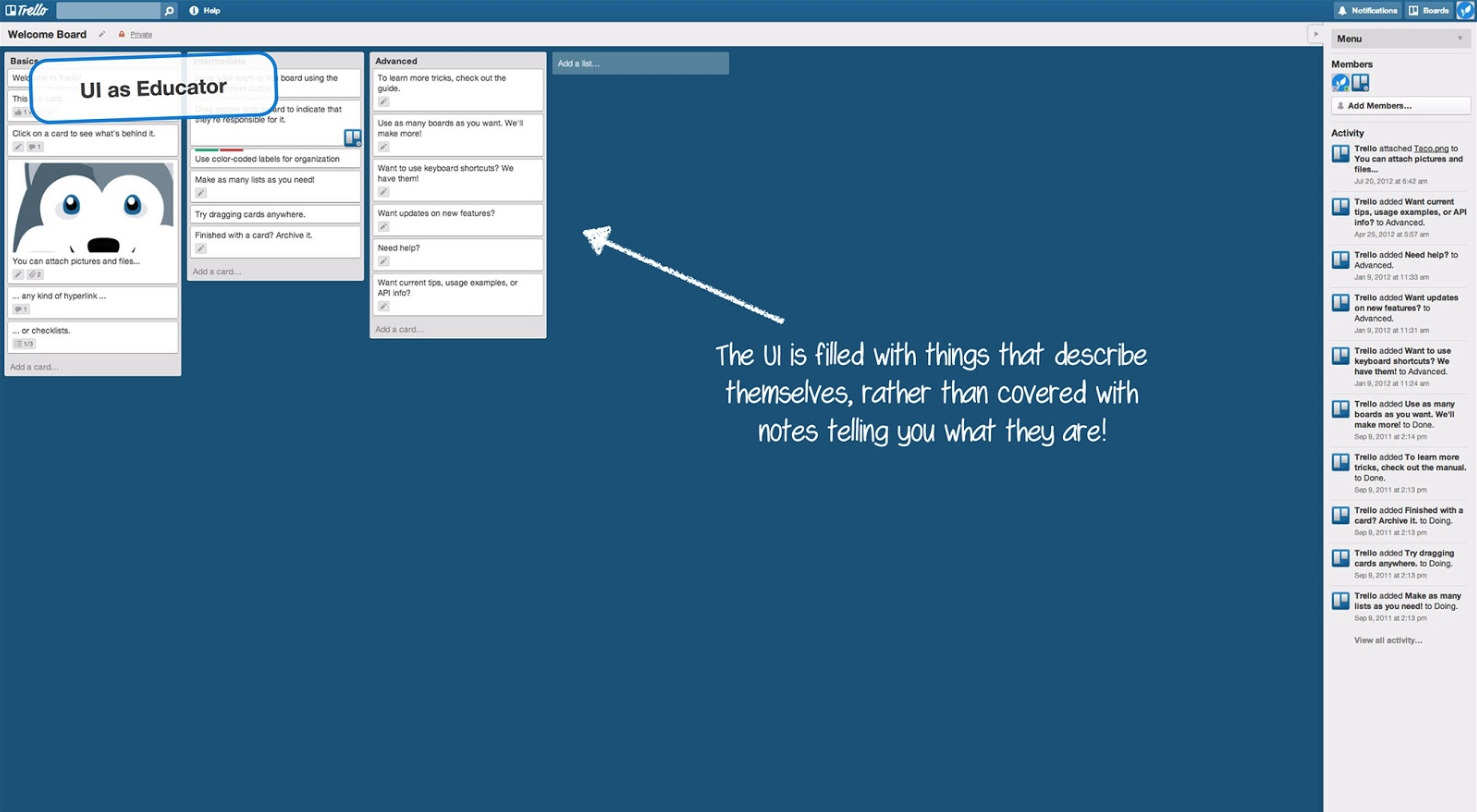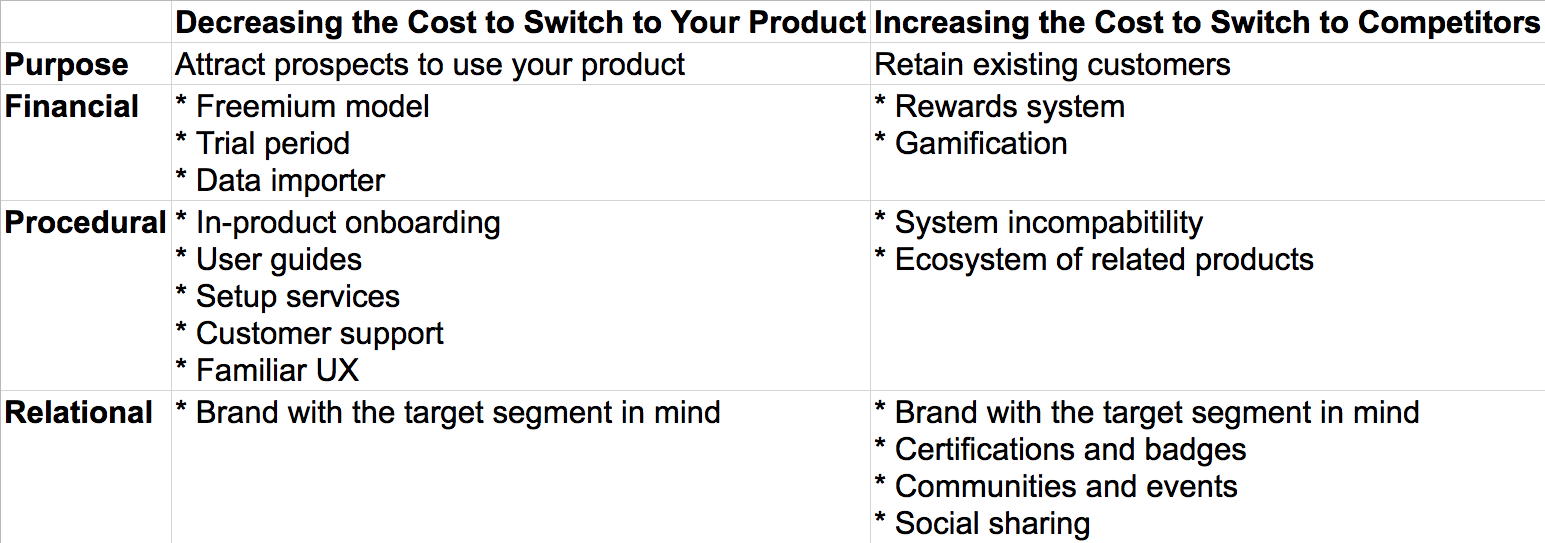In our previous article, we discussed the three core categories of switching costs: financial, procedural, relational.
How might we use switching costs to drive more value from our product? You have two core strategies available to you.
- Decrease the cost your customer must pay to switch to your product
- Increase the cost your customer must pay to switch to competitors
After all, if you decrease the cost to switch to you, you’re providing more value: value is the ratio of benefits to costs. When you drive down costs, you increase the value even if you don’t increase the benefit you provide.
8 Product Strategies for Switching Costs
If you increase the cost to switch to competitors, you are diluting your competitors’ value. Since value is the ratio of benefits to costs, when you increase their costs, you decrease the viability of their value propositions.
Let’s dissect 8 product strategies below.
1. Decreasing the Cost to Switch to Your Product
When you remove the friction and cost needed to switch to your product, you provide a more compelling value proposition to prospects.
That is, reducing the switching cost to your product is inherently a sales tactic. You are explicitly targeting those who have not yet begun to use your product.
Let’s use our three core categories, and talk through examples of successful products that decreased the cost of switching in each category.
2. Decreasing Financial Switching Costs
To reduce financial switching costs, consider using a freemium model for your product.
For example, Slack does a fantastic job of easing users into their paid plans. Slack starts off as free for a limited of users, which means that users can test out using Slack without any negative financial impact. Once a user is convinced of Slack’s value, they can then pay for a higher tier and bring on the rest of their company or organization onto Slack.
Similarly, you can use trial periods for your product to reduce switching costs. While free trials do not decrease the ultimate switching cost that the customer must pay, it at least enables them to get a taste of your product before needing to pay the full amount.
Another way to reduce financial switching costs is to make it incredibly time-effective to set up.
For example, most email clients (Google, Outlook) have a CSV importer that enables you to import all of your contacts. Instead of spending hours typing every contact in, you can just drag-and-drop a file to set all of your contacts up in the new system.
Notice how our switching cost classifications aren’t mutually exclusive – data importer features also decrease relational costs. That’s why Facebook and all have address book importer features so that you can quickly set your relationships back up in their systems. Data importers aren’t sexy features, but they’re incredibly valuable!
3. Decreasing Procedural Switching Costs
To reduce procedural costs, think carefully about your in-product onboarding.
What is your first-time user experience? How do you quickly orient users so that they know what to do next? For example, Trello’s onboarding teaches the user how to use the product through the product itself:

Source: https://www.useronboard.com/how-trello-onboards-new-users/?slide=40
By making it easy to learn how to use your product, you enable users to switch to you without leaving or giving up.
Another way to reduce procedural costs is to provide out-of-product help. Many product managers overlook the importance of reducing procedural switching costs through non-product means!
User manuals, forums, and lifecycle emails with tips and guidance are all great ways to provide out-of-product help. For example, MailChimp has a Get Started guide that quickly enables new users to figure out how to use it.
You can also provide out-of-product help through services and support.
If you have an implementation team or a training team, you can reduce the procedural cost of setting up and maintaining your product. This tactic works especially well in the B2B space.
For example, Intercom enables users to access the Intercom support staff quite easily through its own product, which reduces the pain and confusion associated with switching to a new product. Similarly, Salesforce has consultants who will help customers implement Salesforce.
Yet another strategy for reducing procedural switching costs is by using familiar UX patterns in your product.
As an example, “next” buttons should point to the right, and “back” buttons should point to the left. If you switch these two, you’re introducing unfamiliar patterns to your user, which causes them to struggle.
As another example, many e-commerce now uses the icon of a shopping cart to enable users to jump to their “shopping cart”, which is a holding area that tracks the items they’re seeking to purchase but haven’t yet paid for.
Don’t be fancy and come up with novel UX if you can leverage existing UX patterns – you’ll just cause your users pain and decrease their likelihood of switching to you! Many professionals in the PMHQ community learned this the hard way.

4. Decreasing Relational Switching Costs
As for decreasing relational switching costs, I haven’t yet encountered great ways to reduce the cost of identity change. Whenever a user switches brands, they pay a psychological cost no matter what.
The only principle to keep in mind is that whatever brand you decide to build, ensure that your brand aligns with the kinds of users you want to attract. For example, Snapchat will never be able to capture grandparents, because the Snapchat brand doesn’t resonate at all with grandparents.
That being said, we’ll address relational switching costs in the context of increasing the cost to switch to competitors.
5. Increasing the Cost to Switch to Competitors
Increasing the switching cost away from your product is inherently a retention tactic. You are explicitly targeting your current customer base, not prospects.
While it goes without saying that we should continually provide our users and customers with more and more benefits, we should also consider defensive tactics for preventing competitors from taking our customers – and that means increasing the cost to switch to competitors.
After all, if it’s too expensive to switch to a competitor, your competitor has a worse value proposition than your product does, since the value is the ratio of benefits to cost. By driving up costs, you reduce competitor value.
So, let’s again use our three core categories of switching costs, and talk through examples of successful products that increased the cost of switching in each category.
6. Increasing Financial Switching Costs
To introduce high financial switching costs, consider implementing a rewards system within your product.
You’re not likely to switch to Philz Coffee if you have lots of Starbucks stars, which enables to you get free Starbucks coffee. The same logic applies to your product. If you reward regular users with financial incentives such as coupons and discounts, they are less likely to switch away from you.
Gamification is another way to think about “rewards”, even if they are not financial. As an example, health apps know how critical it is to gamify their experience with achievements, streaks, badges, and leaderboards. I personally own a Fitbit, and due to its achievements system, I refuse to switch to other health trackers such as Samsung Health – just because I would lose all of my achievements.
7. Increasing Procedural Switching Costs
To introduce high procedural switching costs, make it operationally difficult to switch.
For example, you cannot easily export your contacts out of LinkedIn and place them into another social media network. Facebook is incredible at gaining users and retaining them because it has an address book importer, but no exporter – therefore, users are permanently locked into with no way out.
You also cannot install Mac-specific programs on a PC, or PC programs on a Mac, which makes it hard to switch between the two systems. The same phenomenon applies to Android smartphones versus iPhones, and to the Xbox vs. Playstation platforms for video games.
Another way to introduce high procedural switching costs is to integrate multiple features with one another to create an ecosystem.
Creating an ecosystem means that if your user switches away from one of your features, she loses the entire synergistic effect of the ecosystem.
For example, Salesforce does a fantastic job of increasing cost to switch – their lead tracking CRM is paired with a Sales Cloud that enables salespeople to actually work the leads and a Cloud that enables support folks to nurture leads that aren’t yet ready.
If you switched out of Salesforce to some other CRM, you’d lose both of those cloud components.
This is why many companies find a core product, and then build around it – to provide more immediate value, and to increase the switching cost.
8. Increasing Relational Switching Costs
To introduce high relational costs, build a strong brand.
Human beings are inherently emotional, and they associate the products they use with their own identities.
Therefore, ensure that you know who your existing customer base is so that you build your brand in a way that resonates with them. For example, Nike’s customer base is full of athletes, so Nike’s “Just Do It” messaging resonates clearly with them.
Furthermore, you can enhance a person’s identity alignment through certifications and badges. Again, Salesforce rises to the top – its myriad of certifications ensures that users are unwilling to switch away and lose their certificates.
Another way to introduce high relational costs is to create a community.
For example, consider Yelp’s Elite Squad program. The events that Yelp throws for its most engaged users ensure that these users think of themselves as Elite. Furthermore, as each elite Yelper gets to know one another, they will be less inclined to switch away to another platform.
Another way to create community is to introduce social elements to your product if it’s relevant. For example, TikTok enables users to share their videos on QQ, Weibo, and WeChat, which meant that users became heavily invested in their identities on TikTok.
Summary
See the table below for a quick summary of what we’ve discussed.

To have a winning product, you need to build a compelling value proposition – and value is defined as the ratio of benefits to costs. Most product managers know how to build out benefits for their user base, but forget to keep costs in mind.
Decrease the cost to switch to your product so that your value proposition is stronger. Increase the cost to switch away from your product, so that your competitors’ value propositions are weaker.
Have thoughts that you’d like to contribute around product strategies for switching costs? Chat with other product managers around the world in our PMHQ Community!